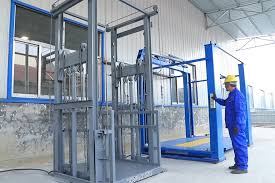
Efficiency is essential to keeping a competitive edge in today’s fast-paced commercial world. Freight lifts are an essential piece of equipment that can greatly increase operational productivity for businesses handling huge amounts of goods. Whether you’re working in an industrial facility, warehouse, or distribution center, purchasing the appropriate freight lift can improve productivity, save time, and streamline workflow. If you’re in the market for a freight lift, it’s essential to know what features to consider before making a purchase. Here’s a guide on how to choose the best freight lift for sale.
1. Understand Your Requirements
Before you begin searching for freight lifts for sale, it’s important to assess your specific needs. Freight lifts come in various types, each designed for different applications. For example, some are more suited for small-scale operations, while others are built for heavy-duty industrial use. Take into account the size and weight of the goods you typically transport, as well as the height you need the lift to reach. Do you need a lift that can handle extra-large items or one that’s perfect for pallets and smaller packages?
By clearly understanding your operational requirements, you’ll be able to narrow down your options and choose the lift that best matches your needs.
2. Capacity And Load Rating
One of the most important factors to consider when purchasing a freight lift is its load capacity. Every lift has a maximum weight; therefore, selecting one with the appropriate capacity is crucial for efficiency and safety. Overloading a freight lift can lead to mechanical failure, accidents, and delays in operations.
When assessing load ratings, consider not only the typical weight of the items you’ll be lifting but also any future needs that may arise as your business grows. Opt for a lift with a slightly higher load capacity than you initially need to ensure that you can accommodate changes in product size and weight over time.
3. Lift Speed And Cycle Time
Time is money in any business, which is why the speed of the lift is an essential factor to consider. Faster lifts can dramatically reduce downtime and improve overall productivity. Check the speed at which the lift operates and ensure that it aligns with your workflow requirements.
It’s also important to evaluate the lift’s cycle time—the amount of time it takes for the lift to complete a full cycle of lifting, lowering, and unloading. The shorter the cycle time, the more goods you can move in a shorter period, increasing efficiency.
4. Safety Features
When choosing equipment for your institution, safety should always come first. The same is true with freight lifts. Make careful to search for elevators with integrated safety features such as anti-slip floors, safety gates, overload protection, and emergency stop buttons. These elements can guarantee adherence to workplace safety requirements, protect your employees, and assist prevent accidents.
Additionally, some freight lifts come with automated safety systems that adjust to prevent lifting or lowering errors. By lowering the possibility of human error, these elements can improve overall operational safety.
5. Durability And Maintenance Needs
Investing in a durable freight lift is crucial for minimizing downtime and repair costs in the long term. Choose elevators made of steel or heavy-duty aluminum to withstand repeated use.
Check the manufacturer’s maintenance guidelines and consider the ease of service and repair. Some lifts may require more frequent maintenance, while others are designed for low-maintenance operation. You’ll want to choose a lift that not only meets your needs but is also reliable and cost-effective in the long run.
6. Ease Of Installation And Operation
A freight lift should be easy to install and operate, minimizing disruption to your operations. Some models come with user-friendly controls, clear instructions, and fast setup processes. If you’re unsure about the installation process, ask the manufacturer if they provide professional installation services.
Additionally, the lift should be simple to operate with intuitive controls that require minimal training. This is especially important if the lift will be used by multiple employees across shifts.
7. Cost And Warranty
Even while it could be tempting to choose the least expensive alternative, it’s crucial to consider the freight lift’s long-term costs. A cheap initial cost could have a lower lifespan or unanticipated maintenance costs. Don’t forget to include in the long-term return on investment when comparing prices for various models and brands.
Moreover, check the warranty that comes with the lift. A solid warranty can provide peace of mind, knowing that you won’t be stuck with expensive repair bills if something goes wrong.
Conclusion
Choosing the right freight lift for your business is an investment in your productivity and efficiency. You may identify the lift that best suits your operational requirements by taking into account variables like weight capacity, speed, safety features, durability, and cost. Take the time to evaluate all of these aspects before making your purchase to ensure that you are investing in equipment that will support your business for years to come.
Leave a Reply